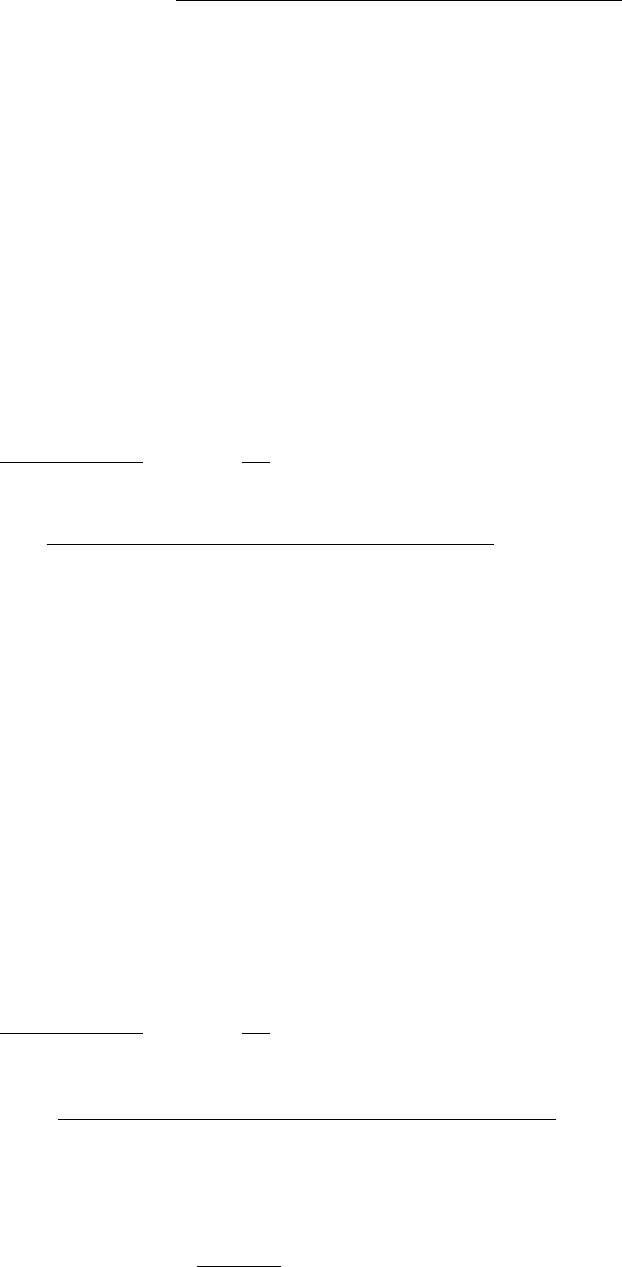
Session #15: Homework Solutions
Problem #1
Iron (
3
ρ 7.86 g/cm
) crystallizes in a BCC unit cell at room temperature.
Calculate the radius of an iron atom in this crystal. At temperatures above 910ºC
iron prefers to be FCC. If we neglect the temperature dependence of the radius of
the iron atom on the grounds that it is negligible, we can calculate the density of
FCC iron. Use this to determine whether iron expands or contracts when it
undergoes transformation from the BCC to the FCC structure.
Solution
In BCC there are 2 atoms per unit cell, so
A
3
molar
N
2
=
V
a
, where
molar
V = A/ρ
; A is
the atomic mass of iron.
A
3
N ρ
2
=
A
a
1
3
A
2A 4
a = = r
N ρ
3
-8
r = 1.24 10 cm
If we assume that change of phase does not change the radius of the iron atom,
then we can repeat the calculation in the context of an FCC crystal structure, i.e.,
4 atoms per unit cell and
a = 2 2r
.
3
3
A
4A
ρ = = 8.60 g/cm
N (2 2r)
FCC iron is more closely packed than BCC suggesting that iron contracts upon
changing from BCC to FCC. This is consistent with the packing density
calculations reported in lecture that give FCC as being 74% dense and BCC 68%
dense. The ratio of the densities calculated here is precisely the same:
7.86 0.68
=
8.60 0.74
Problem #2
Determine the total void volume (cm
3
/mole) for gold (Au) at 27
o
C; make the
hard-sphere approximation in your calculation, and use data provided in the
periodic table.
Solution
First determine the packing density for Au, which is FCC; then relate it to the
molar volume given in the periodic table.

3
3
33
16 r
volume of atoms/unit cell 16 r
3
packing density = = =
volume of unit cell
a 3a
3
3
16 r
packing density 0.74 74%
32
3 16 2r
void volume = 1 – packing density = 26%
From the packing density (74%) we recognize the void volume to be 26%. Given
the molar volume as 10.3 cm
3
/mole, the void volume is:
33
0.26 10.3 cm / mole = 2.68 cm / mole
Problem #3
Determine the atomic (metallic) radius of Mo. Do not give the value listed in the
periodic table; calculate it from other data given.
Solution
Mo: atomic weight = 95.94 g/mole
3
= 10.2 g/cm
BCC, so n = 2 atoms/unit cell
3
3 -6
3 23 3
(95.94 g/mole)(2 atoms/unit cell) m
a = 10
(10.2 g / cm )(6.023 10 atoms/mole) cm
-29 3
3.12 10 m
-10
a = 3.22 10 m
For BCC,
a 3 = 4r
, so
-10
r = 1.39 10 m
Problem #4
A metal is found to have BCC structure, a lattice constant of 3.31 Å, and a density
of 16.6 g/cm
3
. Determine the atomic weight of this element.
Solution
BCC structure, so n = 2
a = 3.31 Å = 3.31 x 10
–10
m
3
= 16.6 g/cm
63
A
N
atomic weight
10 = a
n

23 -10 3
3
-6 3 3
(6.023 10 atoms/mole) (3.31 10 m)
atomic weight = 16.6 g/cm
(2 atoms/unit cell)(10 m /cm )
181.3 g/mole
Problem #5
At 100°C copper (Cu) has a lattice constant of 3.655 Å. What is its density at this
temperature?
Solution
Cu is FCC, so n = 4
a = 3.655 Å = 3.655 x 10
–10
m
atomic weight = 63.55 g/mole
-6 3
A
N
atomic weight
10 = a
n
3
23 -10 3
(63.55 g/mole)(4 atoms/unit cell)
= = 8.64 g/cm
(6.023 10 atoms/mole)(3.655 10 m )
Problem #6
Determine the second-nearest neighbor distance for nickel (Ni) (in pm) at 100° C
if its density at that temperature is 8.83 g/cm
3
.
Solution
Ni: n = 4
atomic weight = 58.70 g/mole
3
= 8.83 g/cm
For a face–centered cubic structure, the second nearest neighbor distance equals
“a” (see LN4–11).
-6 3
A
N
atomic weight
10 = a
n
-6 3 3
3
23 3
(58.70 g/mole)(10 m /cm )(4 atoms /unit cell)
a =
(6.023 10 atoms / mole)(8.83 g / cm )
=
-29 3
4.41 10 m
12
-10 2
10 pm
a 3.61 10 m = 3.61 10 pm
m

Problem #7
Determine the highest linear density of atoms (atoms/m) encountered in
vanadium (V).
Solution
V: atomic weight = 50.94 g/mole
3
= 5.8 g/cm
BCC, so n = 2
The highest density would be found in the [111] direction. To find “a”:
33
A
23
N
atomic weight 50.94 2
= a a =
n
5.8 6.023 10
-8 -10
a = 3.08 10 cm = 3.08 10 m
The length in the [111] direction is
a3
, so there are:
-10
2 atoms / a 3 = 2 atoms/(3.08 10 m 3)
= 3.75 x 10
9
atoms/m
